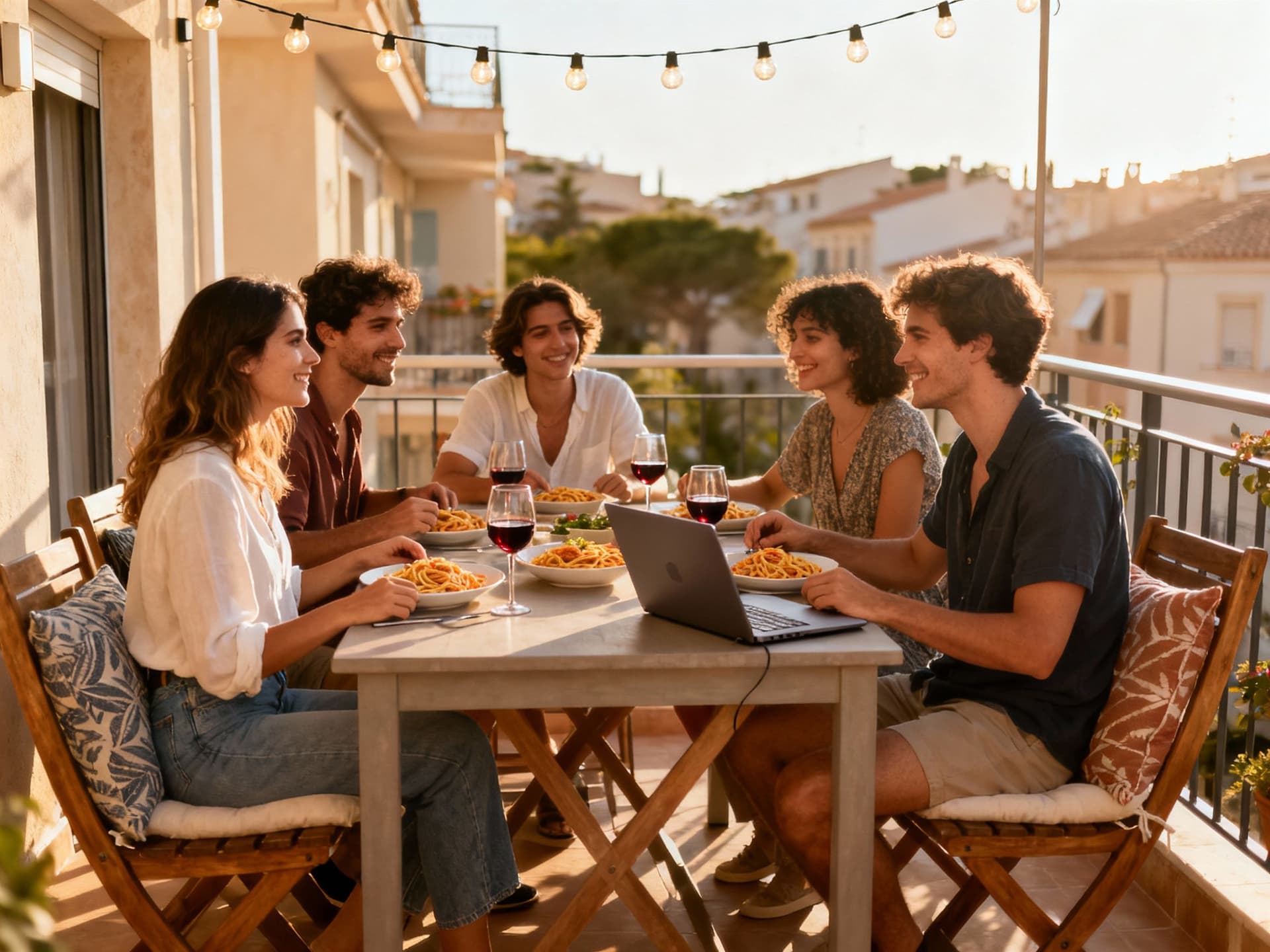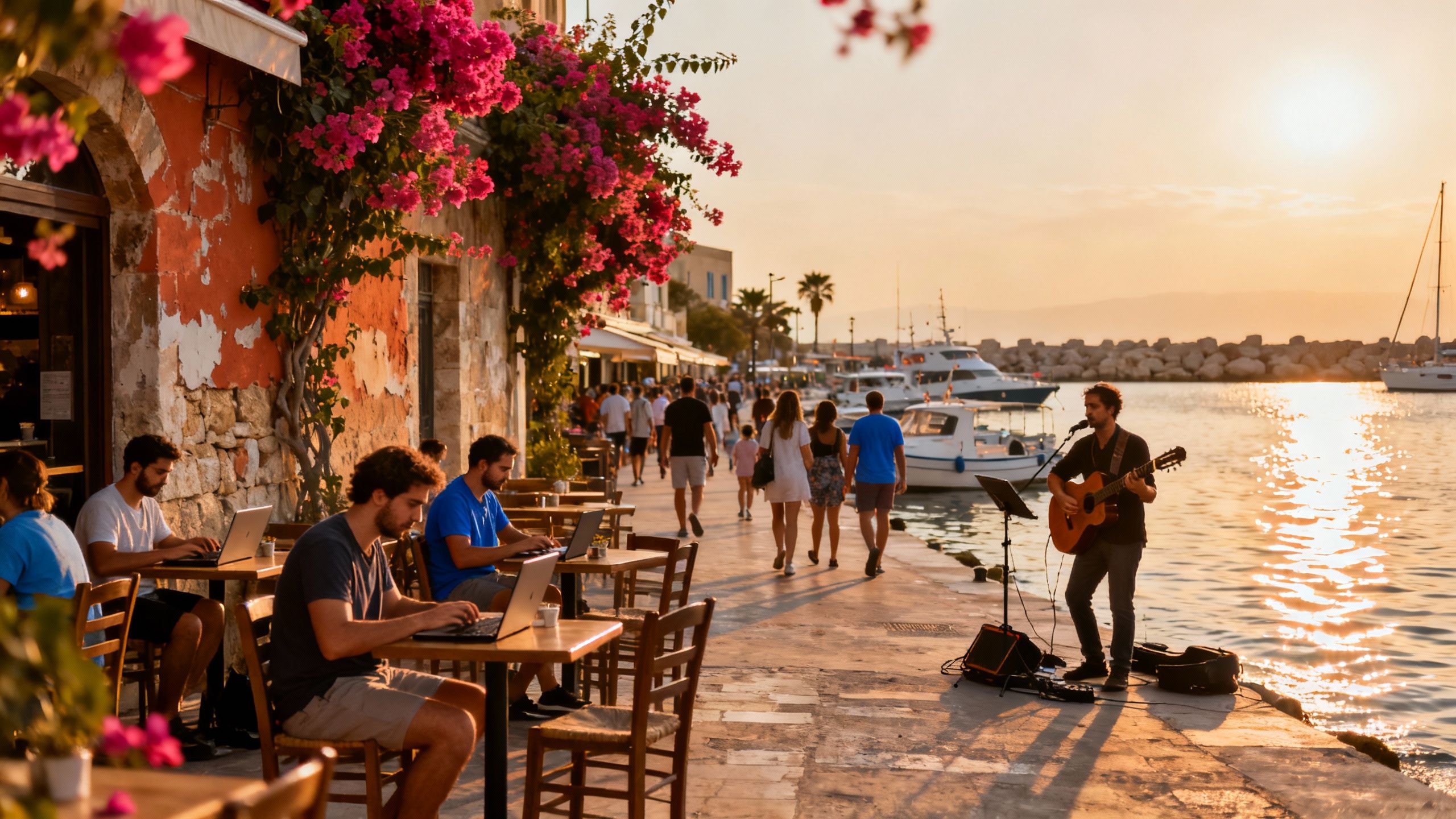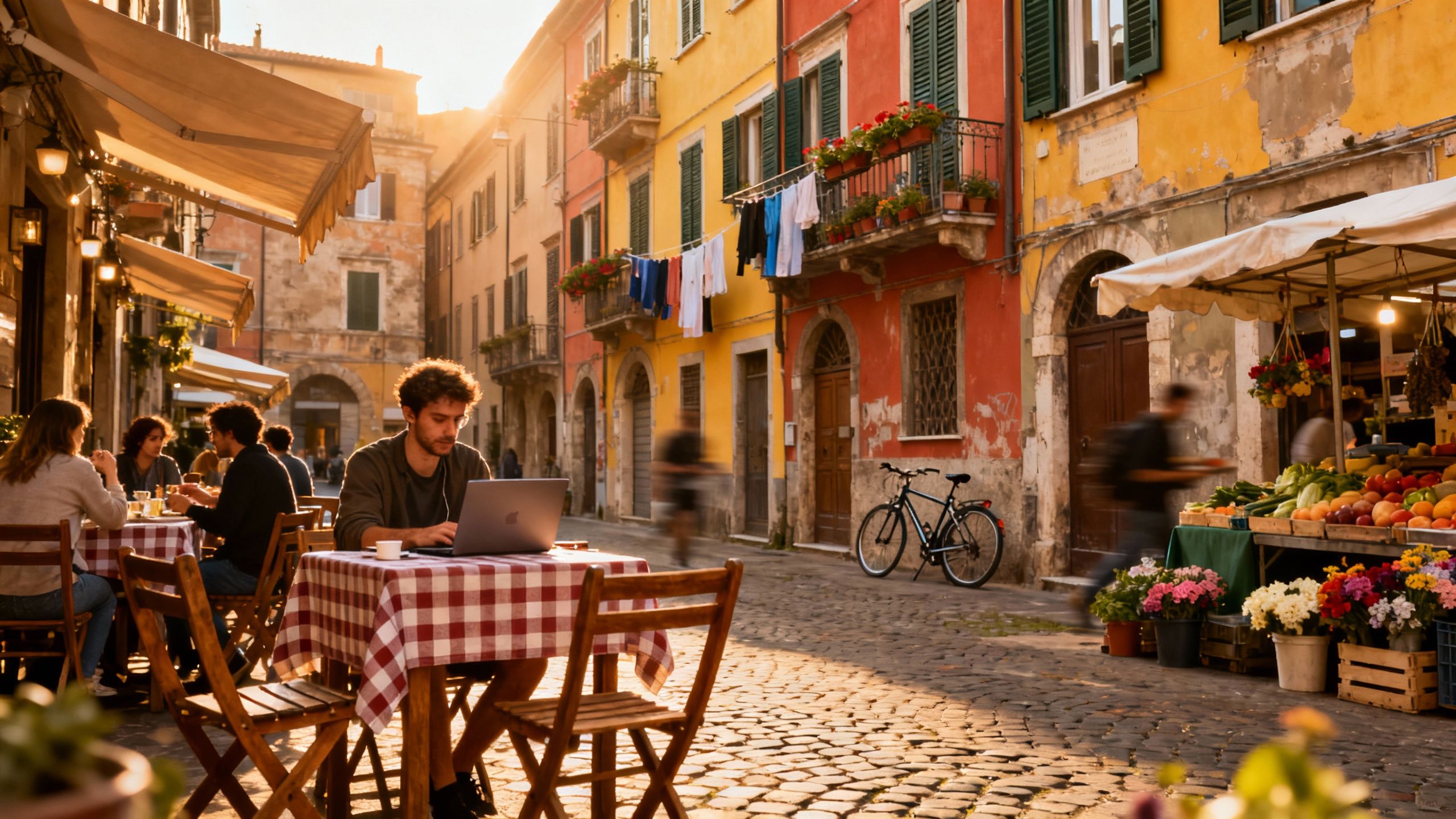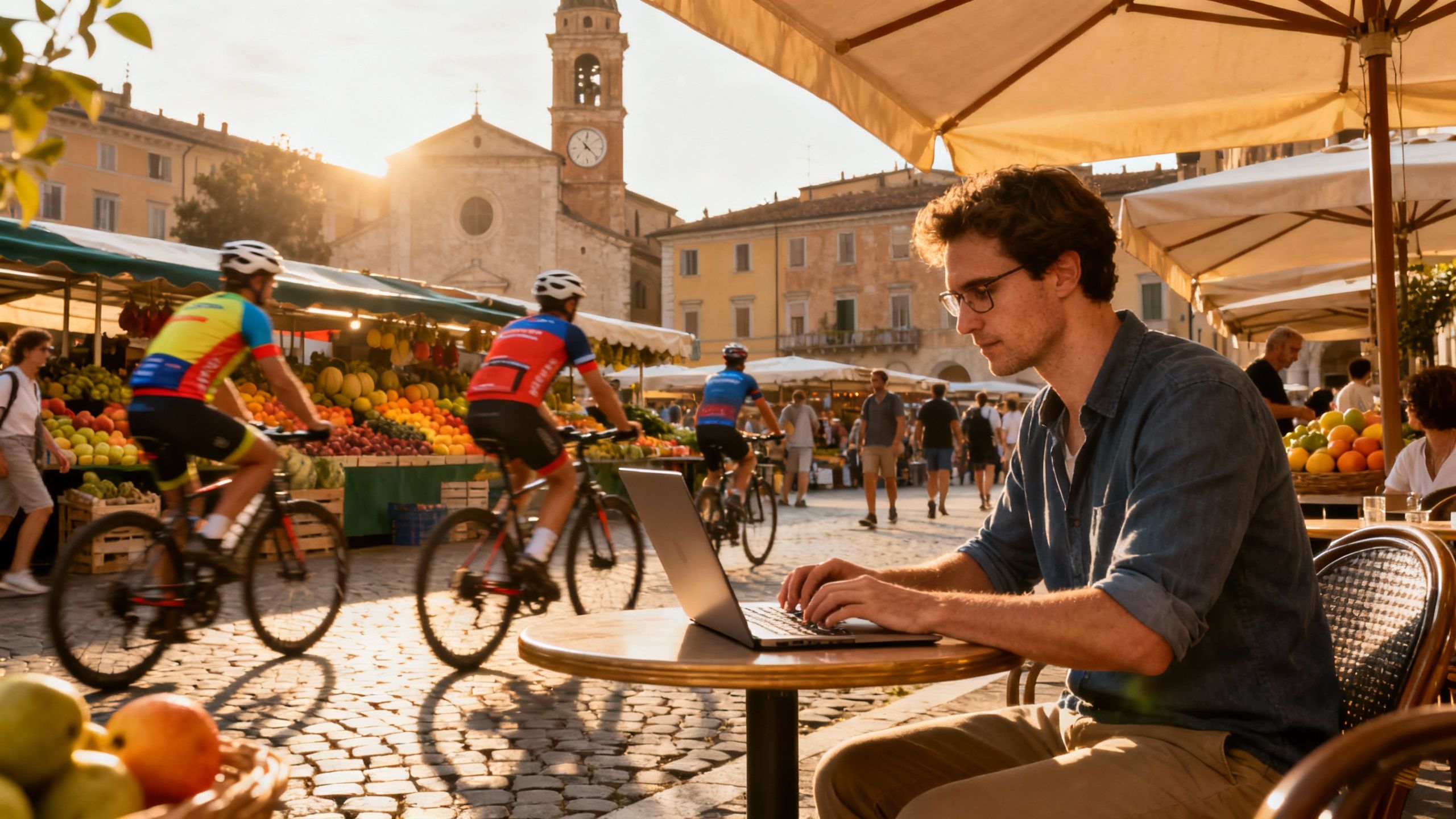The Italian Neighbourhood Everyone Overlooks (and Why It Works)
Italy offers lived-in neighbourhoods where nomads get local life and remote-work practicality; match daily rituals to property choices and verify regional market signals.
Imagine stepping out for an early espresso on a cobbled street where the barista knows your name, then finding a sunny corner table to send a few work emails — that’s Italy in a sentence. The rhythm here is intimate: morning markets, long lunches, late-night passeggiata. For nomads dreaming of a base, Italy offers an intoxicating blend of lived-in history and modern remote-work infrastructure. But beneath the romance are real market moves and surprising neighbourhoods that don’t match the postcards — and that’s where smart buyers win.
Living the Italian lifestyle, beyond the postcard

Italy’s lifestyle is sensory: espresso steam, morning market aromas, the clack of scooters, and piazzas that come alive at dusk. Cities and towns differ wildly — the canals and aperitivo culture of Milan and Venice feel very different from the slow afternoons of Puglia or Liguria’s cliffside villages. As a remote worker you’ll want a place that supports both productive work days and vibrant local life: a neighbourhood with cafes that welcome laptops, fast internet, and a walkable grocery market. Think of lifestyle first — the property should amplify your everyday rituals, not force you to give them up.
Hidden-city pockets that feel like village life
Places like Trastevere (Rome), Oltrarno (Florence) and Navigli-adjacent streets in Milan give you historic streets and neighborhood bars while staying minutes from coworking hubs. They hum with locals buying bread, families chatting in squares, and chefs shopping at daily markets. Rent an apartment with a small terrace and you’ll find yourself living like a local: morning coffee at Bar San Calisto, evening aperitivo on the Arno, or a canal-side walk before a late-night focused session. These pockets show that you can have both authenticity and connectivity.
Food, markets and the social calendar
Markets and dining shape your weekly life: morning fish stalls, aperitivo rituals, neighbourhood trattorias that become your living room. In Rome, markets like Mercato di Testaccio and small osterie are where you meet neighbours; in Bologna, food markets double as coworking-adjacent meeting spots. Seasonal festivals — a chestnut fair in autumn or a summer sagre on the coast — are not tourist spectacles but community glue. For property hunters, that means choosing streets that connect you to daily life, not just vistas.
- Lifestyle highlights to look for when choosing an Italian neighbourhood
- Walkable streets with café culture (e.g., Navigli, Oltrarno, Trastevere)
- Daily markets or greengrocers within a 10–15 minute stroll
- Nearby coworking spaces or reliable café Wi‑Fi (essential for nomads)
- Evening life that’s local — piazzas, not only tourist hotspots
Making the move: lifestyle-first practical considerations

Dreaming of a piazza-view apartment is one thing; closing on it is another. Market signals matter: national house-price indexes showed modest annual gains through 2025, while transactions and mortgage activity have been recovering — a sign that demand is back and varied across regions. That means timing and neighbourhood choice can protect your lifestyle and budget: city-centre pockets often hold value, while overlooked districts can deliver space, sunlight and lower entry prices.
Property styles and how they shape daily life
From compact historic flats with high ceilings to renovated farmhouses in Puglia, each property type dictates routines. A labyrinth apartment in a medieval town means stairs, less storage, and magical rooftops — perfect if you prioritise charm over an elevator. A modernized apartment near Milan’s coworking hubs gives fast connections and stable broadband but costs more. National data show average price growth varied by region in 2025, so match property style to the life you want rather than headline price tags.
Working with local experts who get your life, not just your budget
A good agent in Italy is part cultural translator, part fixer. They’ll tell you which streets sleep after 10pm and which ones host weekly markets that will fill your fridge. Look for agencies with experience helping foreigners — they’ll navigate small but crucial differences like condominium rules (condominio), historic-building constraints, and typical renovation timelines. Agencies that live in the neighbourhoods they sell are the ones who understand where you’ll actually feel at home.
- Practical steps that pair lifestyle with action
- Visit neighbourhoods at different times (weekday morning, Saturday market, weeknight) to test rhythm and noise.
- Check real internet speeds in the exact building and confirm mobile coverage for calls and hotspots.
- Ask an agent about recent comparable sales and how long properties typically stay on the market.
- Factor in renovation time and local permit speed — older buildings often need months, not weeks.
Insider knowledge: expat truths, red flags and seasonal reality
Expats often romanticise the Amalfi coast or central Florence and then discover maintenance, tourist churn and seasonal pricing swings. Locals know which streets empty out in winter and which keep year‑round life. Recent reporting shows investors moving from Milan toward Rome as urban renewal changes value maps — a reminder that opportunity often follows public investment, not just hype. Watch for neighbourhoods near transport upgrades or cultural projects; those are the subtle long-term wins.
Cultural cues that change how you live
In Italy, the social calendar matters: local festivals, market days, and church hours shape services and noise. Learning a few phrases goes a long way — shopkeepers respond to effort, and your neighbours will too. Expect bureaucracy: straightforward things (like registering residency or getting utilities) take time and a local helper. But once you slot into weekly routines — your café, your greengrocer, your walking loop — the intangible benefits of neighbourhood life compound quickly.
Long-term lifestyle and property realities
Think beyond the first year. Buildings that feel charming can show structural quirks later: damp, heating rarity, or complicated condominium rules. If you plan to rent when you travel, choose areas with year-round appeal and solid transport links for guest convenience. And remember: modest annual price growth nationally in 2025 suggests steady, not explosive, capital appreciation. Buying here is as much about buying into a life as it is about the asset.
- Red flags local agents will tell you — check these early
- No official energy certificate (APE) or vague heating info — could mean expensive retrofits later
- High tourist-season rental turnover in the block — lively summers, empty winters
- Unclear condominium minutes — ask for recent meeting notes to spot planned works or levies
Wrapping up: Italy is a lifestyle purchase first and a property purchase second. Get the daily rhythms right — the cafés, markets, and walkability — and the rest will follow. Use agents who live the neighbourhood life, check market data for regional trends (prices rose modestly across Italy in 2025), and test any street at multiple times before signing. Fall in love with a life here, then let careful local expertise turn that feeling into a smart buy.
Danish investor and relocation advisor focusing on Portugal and the Algarve; loves coworking culture and expat networks.


